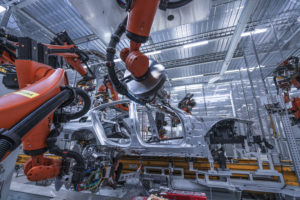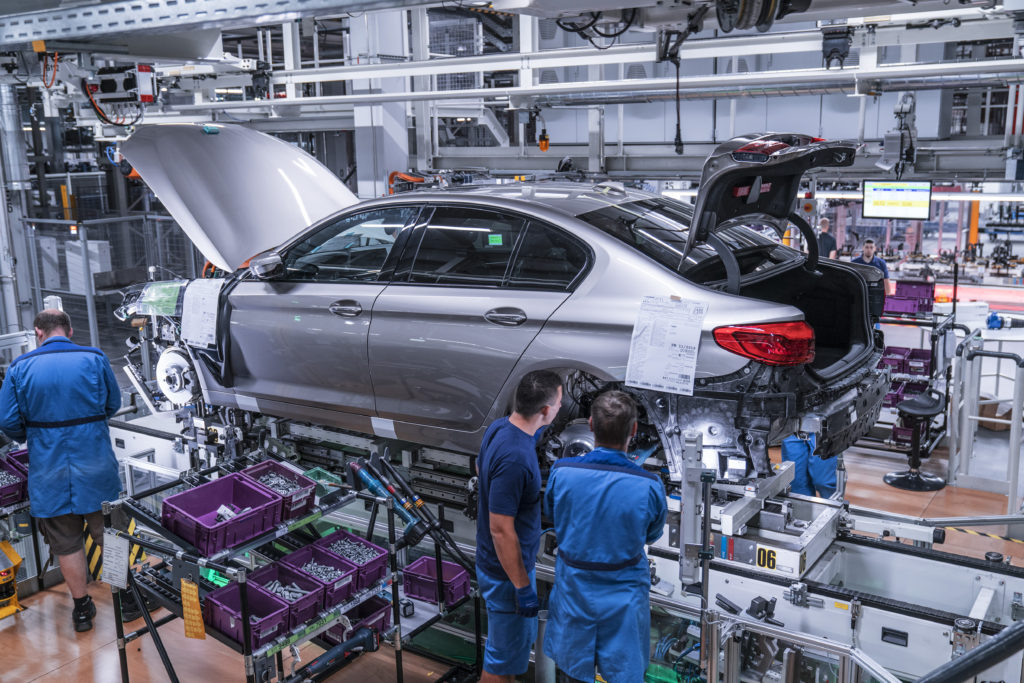
New BMW 5 Series loses 137 lbs.; has aluminum, HS steel, magnesium — but no carbon fiber
By onMarket Trends | Repair Operations | Technology
Though BMW won’t use the “Carbon Core” format of the 7 Series, the next generation of the BMW 5 Series announced Thursday will still lose up to 137 pounds through a combination of high-strength steel, magnesium and aluminum.
The past generation of the 5 Series already relied fairly extensively on aluminum, including the doors, hood and front fenders. The 2017 5 Series builds on this further with its first completely aluminum trunk lid, knocking 9 pounds off the car.
“The trunk, trunk lid, engine cross-member, rear side-members, roof and doors are constructed from aluminum,” BMW wrote Thursday. “The doors, with laser-cut outer paneling, have an aluminum shell construction, which maximizes the weight-reducing benefits of this material when used in combination with state-of-the-art production technologies.”
The hood and fenders are still aluminum, BMW confirmed Friday.
BMW used magnesium to cast the instrument panel, rendering it 4 pounds lighter than its steel predecessor. Given the metal’s high strength, low weight and structural rigidity, this could be an increasingly popular choice for OEMs going forward.
High- and ultra-high-strength steel appear throughout the vehicle, and while BMW indicated it used such metals in its previous-generation 5 Series, you’ll likely see more ultra-high-strength steel and potentially even the lower-strength steels moving up to stronger, lighter high-strength classes.

Large load-bearing members in the new BMW 5 Series Sedan, and strategic use of high- and ultra-high-strength steels in the roof, side members and rear, give the body high structural strength,” BMW wrote about the 2017 5 Series. “The use of hot-stamped steels, aluminum alloys and multi-phase steels in the passenger cell provides high rigidity, for the best possible passive safety and low weight.”
Shops doing structural work on the 2017 5 Series also will want to review OEM procedures to preserve what BMW describes as “optimized safety” on the body-in-white. Interestingly, BMW says the body is optimized for other vehicles’ safety too.
“Deformation spaces are optimally designed and utilized, courtesy of the latest technologies in body design,” BMW wrote. “The aim was to split up the main load paths so that the impact forces are dispersed over as wide an area as possible by the time they reach the extremely rigid passenger cell. This ensures optimal deceleration of the passenger cell in an accident, allowing the front, rear and side impact restraint systems to provide the most effective protection possible.”
Learn about steel, aluminum auto body work at Repairer Driven Education
Shops need to examine steel and aluminum repair to make informed business decisions about how they want to fix modern lightweighted vehicles. Learn more about steel repairs for the Honda Accord, Toyota Camry and Audi A5 at “Case Study of the Procedures for Steel Quarter Panel Replacement” with Larry Montanez of P&L Consultants, and examine “Structural Repair and Materials for 2016 and Beyond” with Ken Boylan of CHIEF Automotive. Both sessions are part of the Repairer Driven Education Series Nov. 1-4 during SEMA. Register here.

As the deformation spaces by definition will likely require the most restoration following a collision, shops’ ability to deliver the same pre-loss energy management will be crucial. And even shops which don’t work on BMWs should heed its message of optimization, as we’ve encountered multiple non-luxury OEMs using similar computer collision modeling to coax similar crashworthiness out of bodies.
The 2017 5 Series won’t use carbon fiber, as had been suggested by what Autocar reported was the model’s switch to the 2016 7 Series’ CLAR architecture.
The 7 Series marries carbon fiber and steel across the vehicle body in a “Carbon Core,” and the CLAR format was intended to allow combinations of carbon-fiber, aluminum, magnesium and/or high-strength steel, Autocar reported in January.
So it appears future Beemers won’t necessarily have as many composites as initially seemed possible; it’s an option, but not a given. We asked BMW spokeswoman Rebecca Kiehne about carbon fiber on the 5 Series, and she replied Thursday via email:
“BMW is pursuing the strategy of intelligent composite construction as a matter of principle. By applying this strategy and by means of optimized details in all areas of the car, we have succeeded in reducing the weight by 137 lbs in the new 5 Series as compared to the predecessor model – despite the increase in size. …
“The Carbon Core technology is reserved for our flagship. The 137 lbs was achieved with the use of magnesium, aluminum and high-strength steel.”
Aerodynamic slats
Besides the usual panel/structural material and design decisions, shops also will want to pay attention to the 5 Series’ active aerodynamic slats.
The high-tech slats, found behind the kidney grille, open and close automatically to balance the radiator’s heat dispersion needs with greater aerodynamics. If the 5 Series rear-ends something, these will be a factor while doing work in the grille area. See our past coverage for more on the technology, which Magna believes will grow more popular with OEMs because of its performance and fuel economy benefits.
Other technology, crash prevention
A luxury vehicle like the 5 Series is going to offer standard or optional all of the driver assistance and convenience systems being rolled out across the U.S. auto industry. Here’s a couple of pieces of technology that particularly stood out to us.
Adaptive headlights now come standard, switching from high and low beams automatically. According to BMW, they also make the car “a captivating prospect, its concentrated gaze locked onto the road.” (Do not get into a staring contest.)
The BMW’s heads-up display can project traffic, navigation, phone, music and safety warning information on a 75 percent larger part of the windshield than in the prior generation.
BMW’s active cruise control, which modifies one’s speed to maintain a safe following distance, sounds pretty impressive in terms of the speeds and road types it can handle and its ability to look two vehicles ahead — and it even takes bad weather into account. Another version handles low speeds.
“The system operates at all speeds up to 130 mph and is capable of braking to a standstill in stop & go traffic and automatically senses if the vehicle in front is moving once more,” BMW wrote. “If the vehicle has been placed into standby mode by pushing the resume button on the steering wheel, the all-new BMW 5 Series can automatically start moving again up to 30 seconds after coming to a full-stop. The ACC system now also takes into account highway exits and traffic circles, where it adjusts the acceleration dynamics to suit these special traffic situations. The control technology monitors two vehicles ahead so that vehicle speed can be adjusted earlier and smoother. Heating elements ensure that the front-mounted radar sensor remains fully operational even if snow is falling.”
The car can automatically swerve itself around an obstacle at up to 100 mph, and it checks sensors to ensure it’s not just swerving into something else. It also can watch blind spots and maintain one’s lane at speeds between 12-130 mph or 40-130 mph, depending on the system.
The car can park itself, including in parallel-park spaces only 30 inches longer than the car, and it can “see” parking spaces at up to 22 mph. It also receives vacancy data from local parking garages and, in a “world premiere,” a form of predictive modeling that forecasts how likely it is that you’ll be able to find a parking spot on a particular street at that point in time.
More information:
“The All-New 2017 BMW 5 Series: Performance, Redefined”
BMW, Oct. 13, 2016
“The All-New 6th Generation BMW 5 Series Sedans”
BMW, Oct. 1, 2010
Images:
A 5 Series underbody structure is welded in BMW’s Dingolfing, Germany, plant in October 2016. (Provided by BMW)
The hood and, for the first time, the entire trunk lid, on the BMW 5 Series will be made from aluminum. (Provided by BMW)
